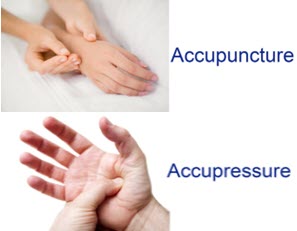Introduction to Acupuncture and Acupressure
Acupuncture
Acupuncture is a medical protocol focused on correcting imbalances of energy in the body. From its inception in China more than 2,500 years ago, acupuncture has been used traditionally to prevent, diagnose and treat disease, as well as to improve general health. The goal of acupuncture is to restore the balance of energy which flows through the body.
When visiting an acupuncturist the first thing that will happen is a comprehensive health assessment. During the questioning and examination, the practitioner may ask to examine your tongue, feel your pulse to help determine energy flow, or ask many questions related to bowel habits and diet. The purpose is for the practitioner to determine where the energy is flowing and where it is not. After the assessment, the needles are placed in very specific locations. The needles are usually left in place for five to 20 minutes, usually no longer than 60 minutes, and then removed.
Following treatment, practitioners will do another assessment and offer recommendations for home care. Acute symptoms may require only two to four treatments; whereas, for chronic cases, it is common to have as many as 12 or more treatments, usually over a course of 8 to 10 weeks. Regular monthly visits may be suggested as preventive measures to decrease stress, improve energy or boost immunity.
Acupressure
Acupressure, like acupuncture, is focused on correcting imbalances of energy in the body. The difference is that acupressure uses gentle and direct pressure to specific areas rather than inserting needles, which makes it a safe and effective therapy.
The pressure applied to an acupressure point should not be too hard. It needs to be just enough to feel the resistance of the muscle tissue. You may feel a warm, cool or tingling sensation. This is called “meeting the point”. However, not all people will experience these sensations during an acupressure session.
The benefits of acupressure are the same as acupuncture and include pain relief, balancing body energy, and maintaining good health. They reduce muscular tension, increase circulation, and enable deep relaxation. By relieving stress, both therapies strengthen resistance to disease and promote wellness. You can learn self-care applications and pressure point formulas for specific conditions, such as chronic fatigue, fibromyalgia, chronic muscular pain, mental stress, addiction recovery, learning disorders, trauma, emotional imbalances and more.

